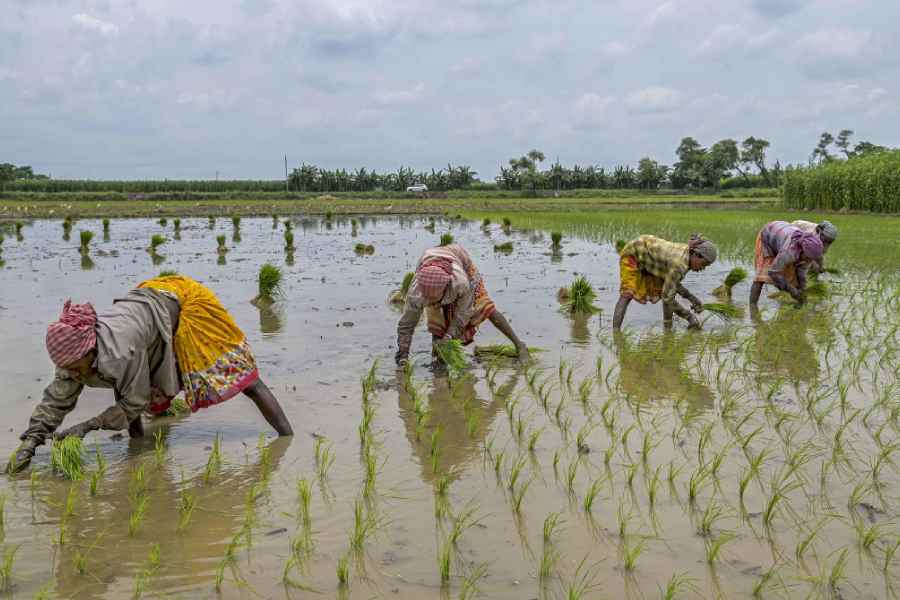Our school biology textbooks speak of extinct animals and plants. But what about crop varieties? According to the National Bureau of Plant Genetic Resources, India had 82,000 varieties of rice, 38,000 kinds of wheat, 10,000 of pigeon peas, 16,000 of gram, 3,668 kinds of brinjal, 46,000 various millets, 4,000 amaranth varieties, 21 types of cattle breed and so on. But there has been a colossal loss in our crop biodiversity — key to food security — since the Green Revolution. Surprisingly, it doesn’t find any mention in our textbooks.
The Statistical Account of Bengal (1875) mentioned district-wise rice varieties. West Bengal and Bangladesh had nearly 10,000 traditional rice varieties. Sadly, researchers have found that nearly 98% of those varieties are now extinct. They include Pabashi, Kachanani, Hatirdani, Chhoto Josowa, Amjhuki, Katisal, Banful, Chitrasali, Nona, Ora, Droupodisal, Arjunsal, Manik Kalma, Tiasali, Kara, Patnai Hur, Parangi, Guligati, among others. Guligati, a deep-water boro rice in Falta block of South 24 Parganas, was found for the last time in 1998.
Crop varieties often become extinct. Non-cultivation on account of aberrations in weather and sheer neglect are some of the possible causes even though our forefathers selected and nurtured these varieties for posterity. During the Green Revolution, it was alleged that all TRVs are low-yielders. This was done purposely to facilitate the so called ‘modern’ varieties that require chemical fertilisers and pesticides. TRVs are good yielders; but they also have other unique qualities. Yield apart, we need to consider other factors like their adaptability, soil, climate, compatibility with other crops, stress tolerance and so on. Yet, mainstream agricultural policy has not done enough to propagate these eco-friendly crop varieties.
The article, “Paddy Yields in Pre-industrial South India” (G. Pingle, EPW, 2017), showed that the average yield of rice of 130 villages in Tamil Nadu was more than 8 metric tonnes per hectare. In 1952, a farmer from Karnataka was given the Krishi Pandit Award by the Government of India for a rice yield of 10 MT per ha. R.H. Richharia, a famous rice researcher and the former director of the Central Rice Research Institute, Cuttack, had selected some TRVs having an yield potential of 5-7 MT per ha. During that period, the average yield of rice in India was less than 2 MT per ha. Surprisingly, in 2022, the average yield of rice in India was around 2.8 MT per ha.
Based on rice and wheat, the Green Revolution was launched on account of the perceived threat of famine. India’s vast traditional arena of ecofriendly cereals like millet and maize was ignored. A massive propaganda in favour of chemical farming with monoculture pushed back research in and promotion of high-yielding TRVs. Richharia warned that japonica rice varieties introduced in India without plant quarantine would spread rice disease. Ultimately, the situation forced Richharia to resign from his post. Farmers began believing that all TRVS were low yielders. They ignored their low cost of cultivation, nutritive qualities, adaptability in marginal lands, and the tradition of fish-cum-paddy culture with TRVs that was profitable economically and ecologically. With the passage of time, TRVs like deepwater paddy, salt-tolerant paddy, drought and flood tolerant paddy, paddy for broadcasting in upland declined drastically. No modern variety can replace these; nor are they a match for them. The yield of modern varieties declines after some years; then a new rice variety comes in the market requiring greater chemical fertilisers. And the cycle goes on.
In 1975, 1 kilogramme of nitrogen, phosphate and potassium fertiliser roughly yielded a grain of 15 kg; now, farmers are using more chemical fertilisers but the yield is far from adequate. Farming has become costly. The input costs of fertilisers, pesticides and seeds have increased manifold. Meanwhile, some of the other consequences of the Green Revolution are being felt — the pollution of crops, soil, groundwater, air, the decimation of pollinating insect populations, declining soil fertility and crop productivity, and the rise in human diseases. After Cyclone Aila, Sunderbans’ farmers have realised the utility of traditional salt tolerant varieties as their modern counterparts — Lunisri is one example — failed miserably.
West Bengal has some high-yielding TRVs such as Kerala Sundari, Bahurupi, Talmuli, Kesabsal, Rabansal, and Bangla Patnai. The Agricultural Training Centre, Fulia, under the directorate of agriculture, West Bengal, has been engaged in conservation work for more than 20 years and is re-popularising TRVs among farmers. The DAC is also promoting TRVs among farmers through various schemes. The ATC has introduced Maharashtra’s Kalabhat, the most nutritious rice in the world, as well as a variety of black rice in Bengal. The state is currently producing more or less 400 MT per year. Some of the TVRs contain 3.5mg-8.5 mg of iron per 100 grammes of rice. The iron content in modern rice varieties is generally more or less 2.5mg/100g. Some TRVs — particularly in red and black rice varieties — have beta carotene and the cancer preventive anthocyanin. Unpolished rice is good for diabetes patients and lactating mothers. The other varieties that have gained popularity are Adanshilpa (red aromatic rice), Joy Prakash (short fine rice), and Mallifulo (short duration aromatic rice with medium grain). Various nutritive red rice varieties such as Shatia, Kalamkathi, Lal Dudhersar are also being cultivated. Apart from Dudhersar, other fine rice varieties like Bansful, Chamarmani, Lalsuru, Sitasal, and Kalamkathi have been accepted by farmers. However, these rice varieties are not being sold in the market on a large scale. Hearteningly, some companies are selling these in small stores and the trend has gained momentum. They are also available online. The Sufal Bangla wing of the agriculture marketing department is also promoting TRVs in different districts.
These trends, if they were to catch on, would be a boost for crop diversity, farmers and the ecology.
Anupam Paul is former Additional Director of Agriculture (P), West Bengal










